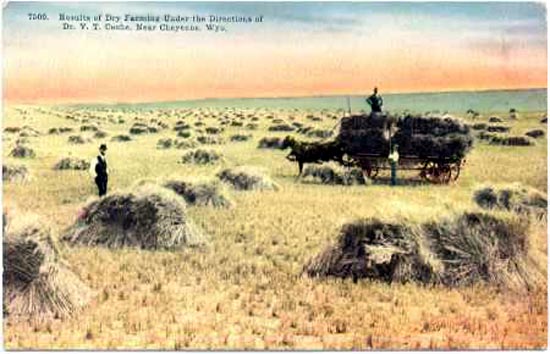
"Results of Dry Farming Under The Direction of Dr. V. T. Cooke, Near Cheyenne, Wyo.," 1906
And at the same time as developers were promoting irrigation, other efforts at bringing prosperity to
the state were made by the promise of agricultural development using
"dry farming." In 1906, John L. Cowan published his Dry Farming -- The Hope of the West, A Method of Producing Bountiful Crops Without
Irrigation in Semi-Arid Regions. Thus, Gov. B. B. Brooks chaired a Dry Farming Congress in Cheyenne in 1909. Notwithstanding, that
a snow storm reduced expected attendance, some 500 delegates were present. The following
year, another congress was held in Spokane under the chairmanship of Wyoming Congressman Frank
W. Mondell. Congressman Mondell had, himself, successfully utilized dry farming methods near Newcastle for five years.
Indeed, Professor of Botony and later president of the University of
Wyoming Aven Nelson joined the band wagon. In 1911, Dr. Nelson told an assemblage in
Cheyenne that with farming as the "backbone of our prosperity," the state might attain a population as much as
"two millions of people." There were some naysayers such as Bill Nye, publisher of Laramie Daily Boomerang, who earlier wrote,
Unless the yield this fall of most agates and prickly pears should be unusually large,
the agricultural export will be far below preceeding years, and
there may be actual suffering. I do not wish to discourage those who might
wish to come to this place but the soil is quite course, and the agriculturist,
before he can even begin with any prospect of sucess, must run his farm
through a stamp-mill in order to make it sufficiently mellow.
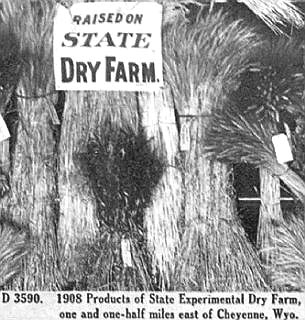 Dry Farming Exhibit, Wyoming State Fair, Douglas, 1908
Dry Farming Exhibit, Wyoming State Fair, Douglas, 1908
The historical premise for dry farming was explained by a Utah proponent Dr.
John A. Widstoe in his Dry-Farming, A System of Agriculture for Countries Under Low Rainfall, The
Macmillan Company, New York, 1920:
The great nations of antiquity lived and prospered in arid and semiarid
countries. In the more or less rainless regions of China, Mesopotamia,
Palestine, Egypt, Mexico, and Peru, the greatest cities and the mightiest
peoples flourished in ancient days. Of the great civilizations of history
only that of Europe has rooted in a humid climate. As Hilgard has suggested,
history teaches that a high civilization goes hand in hand with a soil that
thirsts for water. To-day, current events point to the arid and semiarid
regions as the chief dependence of our modern civilization.
In view of these facts it may be inferred that dry-farming is an ancient
practice. It is improbable that intelligent men and women could live in
Mesopotamia, for example, for thousands of years without discovering methods
whereby the fertile soils could be made to produce crops in a small degree
at least without irrigation. True, the low development of implements for
soil culture makes it fairly certain that dry-farming in those days was
practiced only with infinite labor and patience; and that the great ancient
nations found it much easier to construct great irrigation systems which
would make crops certain with a minimum of soil tillage, than so thoroughly
to till the soil with imperfect implements as to produce certain yields
without irrigation. Thus is explained the fact that the historians of
antiquity speak at length of the wonderful irrigation systems, but refer to
other forms of agriculture in a most casual manner. While the absence of
agricultural machinery makes it very doubtful whether dry-farming was
practiced extensively in olden days, yet there can be little doubt of the
high antiquity of the practice.
Kearney quotes Tunis as an example of the possible extent of dry-farming
in early historical days. Tunis is under an average rainfall of about nine
inches, and there are no evidences of irrigation having been practiced
there, yet at El Djem are the ruins of an amphitheater large enough to
accommodate sixty thousand persons, and in an area of one hundred square
miles there were fifteen towns and forty-five villages. The country,
therefore, must have been densely populated. In the seventh century,
according to the Roman records, there were two million five hundred
thousand acres of olive trees growing in Tunis and cultivated without
irrigation. That these stupendous groves yielded well is indicated by the
statement that, under the Caesar's Tunis was taxed three hundred thousand
gallons of olive oil annually. The production of oil was so great that from
one town it was piped to the nearest shipping port. This historical fact is
borne out by the present revival of olive culture in Tunis, mentioned in
Chapter XII.
Moreover, many of the primitive peoples of to-day, the Chinese, Hindus,
Mexicans, and the American Indians, are cultivating large areas of land by
dry-farm methods, often highly perfected, which have been developed
generations ago, and have been handed down to the present day. Martin
relates that the Tarahumari Indians of northern Chihuahua, who are among
the most thriving aboriginal tribes of northern Mexico, till the soil by
dry-farm methods and succeed in raising annually large quantities of corn
and other crops. A crop failure among them is very uncommon. The early
American explorers, especially the Catholic fathers, found occasional
tribes in various parts of America cultivating the soil successfully
without irrigation. All this points to the high antiquity of agriculture
without irrigation in arid and semiarid countries.
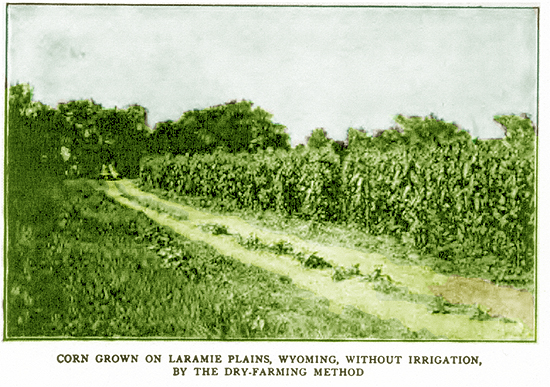
Dry Farming corn, near Laramie, 1906
The Agricultural Experiment Station confidently predicted that with dry farming one-fourth
the state could be profitably farmed on a regular basis and that half of the remainder of the state
could be profitably farmed without irrigation in a majority of seasons. Dry farming rested on the
premise that with deep plowing and harrowing of the soil after rain, that the
water would be stored for use of the crops. The problem, according to the "experts" such as
Dr. V. T. Cooke, was not lack of
rain, but with evaporation. Dr. Cooke was brought in from Oregon by Cheyenne businessmen to
promote the benefits of dry farming.
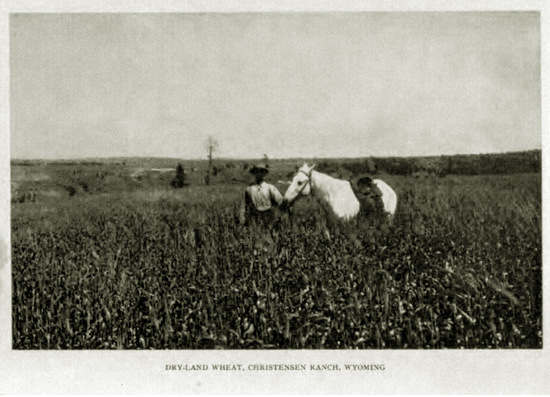
Dry Farming wheat Christensen Ranch, 1906.
The enthusiasm for dry farming was in partial reaction to a paper on the subject written by the
State Engineer Clarence J. Johnston. John L. Cowan explained:
[T]he members of the Young Men's Club of Cheyenne, Wyoming, listened to the
reading of a paper on the subject of dry farming by State Engineer Clarence J. Johnston. A project was at
once set on foot for the opening of a demonstration farm on waste lands near the city, supposed to be
entirely worthless without irrigation. The farm was put in charge of
Mr. F. C. Herman of the Irrigation and Drainage Bureau of the United States Department of
Agriculture. Last season record breaking crops of corn, otatoes, peas, oats, and garden
vegetables were grown on those "waste" lands. Winter wheat, rye, alfalfa, and barley were
also sown. Within ten days the grain was ten inches high, covering with a perfect carpet of green
the land that had been considered incapable of raising anything.
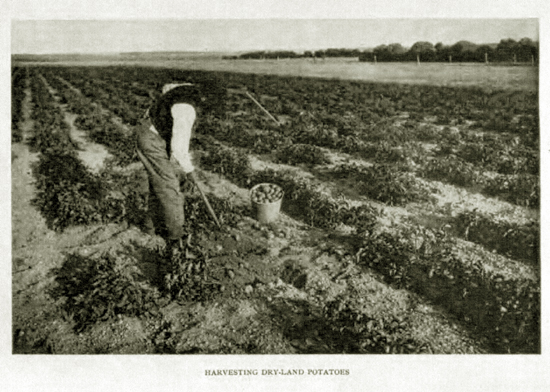
Dry Farming Potatoes, 1906.
With numerous books and magazine articles being written, publicity given by dry farming congresses,
reports from agrricultural experiment stations, and promotion by railroads, a wave of homesteading
spread across the northern plains, the Dakotas,
Montana, and Wyoming. The railroads, of course, needed a population to serve and were to a great
extent a real estate sales operation. Brochures were distributed across eastern Europe and the
immigrants came. In some areas, derision greated the new settlers. The 160 acres was, in many instances,
too small for effective dry farming. In some areas the new dryfarm settlers were called "honyockers,"
pronounced "hawnyawkers," drerived from the German huhn jäger, hen hunter, a chicken chaser.
In her 1912 novel, The Lady Doc, Cody writer Caroline Lockhart described the coming of the homesteaders to her
fictional town of "Crowheart":
They came in prairie schooners, travel-stained and
weary, their horses thin and jaded from the long,
heavy pull across the sandy trail of the sagebrush
desert. With funds barely sufficient for horse feed
and a few weeks' provisions, they came without definite
knowledge of conditions or plans. A rumor
had reached them back there in Minnesota or Iowa,
Nebraska or Missouri, of the opportunities in this new
country and, anyway, they wanted to move—where
was not a matter of great moment. Others came by
rail, all bearing the earmarks of straitened circumstances,
and few of them with any but the most
vague ideas as to what they had come for beyond the
universal expectation of getting rich, somehow, somewhere,
some time. They were poor alike, and the first
efforts of the head of each household were spent in
the construction of a place of shelter for himself and
family. The makeshifts of poverty were seldom if
ever the subject of ridicule or comment, for most
had a sympathetic understanding of the emergencies
which made them necessary. Kindness, helpfulness,
good-fellowship were in the air.

Dry Farm Cabin, 1912
As noted with regard to the Tallmadge and
Buntin Land Co. on the preceding page, a drought hit the state in 1910. A worse droght hit beginning about
1920 leading to the Dust Bowl. Dry Farming generally
needs a minimum of 15 inches of rain a year. Thus, the promotions of dry farming
turned to dust with the drought, and the state marked a substantial decline in
acreage devoted to dry farming. The impact of the end of dry farming may be illustrated by what transpired on the
Chugwater Flats and Iowa Flats on the plateau to the east of Chugwater. The two communities blended together with
Cugwater Flats being primarily in Platte County and Iowa Flats primarily in Goshen County. Beginning in 1911, Iowa Flats was also referred to as
"Iowa Center" becasue of the name after a post office was established in 1911.
Because of confidence in a change of climate that made dry farming
farming in such an area feasible, the area was opened to homesteading in 1908.

Iowa Flats Advertisement.
Beginning in 1909 many farmers from Iowa were attracted by glowing reports to Iowa Flats, so called as a result of the number
persons from Iowa who settled in the area. Foremost among them was former Iowa school teacher Robert A.Kletzing.
Mr. Kletzing published a pamphlet extolling the vitues of Iowa Flats. Additionally, glowing letters were published in various
Iowa newspapers.One such letter published in the Ottunwa Tri-Weekly Courier on September 2, 1911:
I am located on a homestead thirteen miles east of
Chug-Water and like it fine. We have a delightful climate.
Also excelent water which is reached at a depth of
100 feet. Out of the 365 days in the year, we have
330 days of sunshine. Our storms, while
severe, last only a few hours. The early return of the sun
soon dries the surface and thus we are bored but little with mud and dampness. In th summer
we enjoy cool breezes from the mountains which lessens the heat of
the day and makes the nights suitable for sleeping.
Land of Promise.
In connection with climate one thinks of
water. This part of Wyoming is blessed with an abundance of pure spring and
vein water. A year ago there were only fifteen shacks here,
now there are 375 familes with homes and improvements. Every one here
seems to be satisfied with the prospects.
Nearly all are breaking the prairie sod and planning for an early
planting in the spring. Those who put in crops early last sping had very good results depite a shortage of rain this past
summer. To show the faith settlers there have of the changes of this country, there
are three steam and gasoline engines and plows within a radius of eight miles.
Have church and School.
Sometimes lack of schools and churches are a drawback in a new country.
We are well provided with both here. There are but a few children that are not within three mils of a school house here. There is one
central church, a fine building and a salaried minister. In conjunction with this,
Sunday school is held in various places.
Leave Cattle Business.
There are many catle and sheep ranches here. One firm has been running
25,000 head of cattle and sheep on this range and are now shipping all of them and going into the sheep
business. The reason for this is because the homestead settlers are taking up the
range. this firm shipped 4,000 head from
Chug-Water Wednesday and Thursday of last week. The firm has now 100,000 head of sheep and are
planning to increase it to more than
200,000. A large number of antelope
about in this region and there are also many of the moaning but harmless coyotes.
I have 150+ acres and twenty acres broke at the cost of $3 per acre. School sections are selling from $13 to $17 per acre.
Potatoes are selling at $1.16 per 100 pounds. Nearly all of the settlers are from Iowa and the country around here is known as Iowa Flats.
Charles Bacon.
Kletzing in his promotional booklet so as to reasure the reader of plentiful water including a photograph of
Frank Marsh's property with what purportedly depicted a spring coming out of the side of a hill next to a spring house.

Purported Spring on Frank Marsh's property.
Although Kletzing referred to Marsh's property as being southeast of Iowa Flats, in the context in which given
it might be regarded as misleading. Marsh's land was in Meriden about 18 miles away and about 500 feet
lower in elevation. About the time of the book, Marsh lived at Wyncote, now a ghost town located near
Torrington. Nor was Frank Marsh a recent homesteader. He was a partner with Jess Yoder in the
Yoder-Marsh Cattle Co.

Charles and Belle Downing in front of homestead. Mrs. Downing also taught in the Iowa Center School.
The small cabin in the back was Downing's original homestead cabin. It was described in his "Recollections" as:
It was
"* * * a shack ten feet square with two windows. The
door, made from the extra lumber, faced south. The roof slanted
to the north and the floor was made of shiplap boards six inches
wide. There was no foundation, just runners on small pieces of
prairie stone; and it was unpainted. A drop side cot; a three-
legged, wood-burning stove; a table built from two-by-fours; and a
kerosene lamp completed the furnishings.
Music this page: Yodeling Slim Clark singing "Little Old Sod Shanty."
Next page: Iowa and Chugwater Flats continued.
|